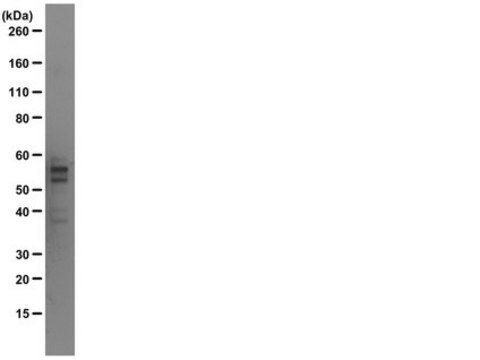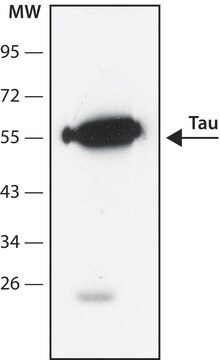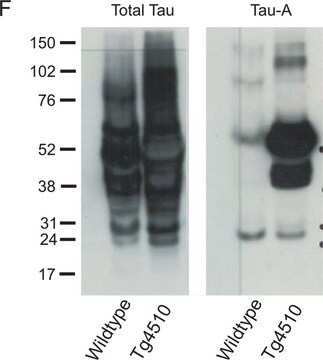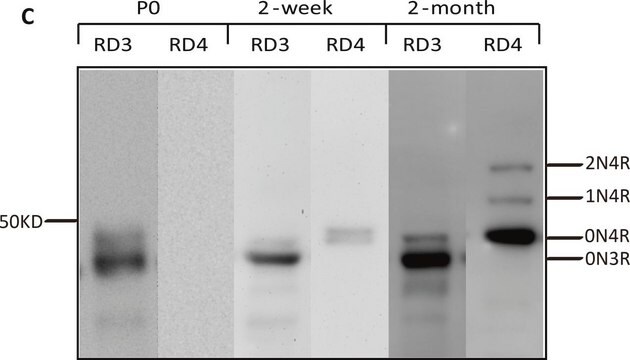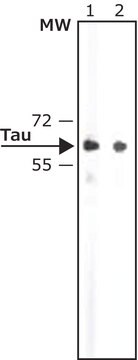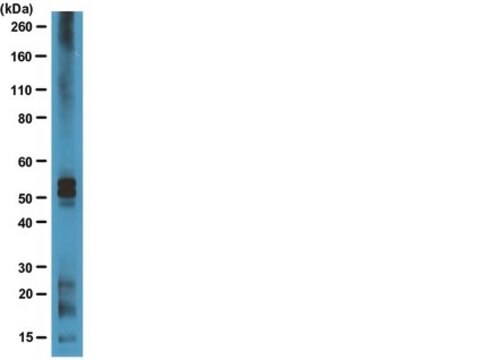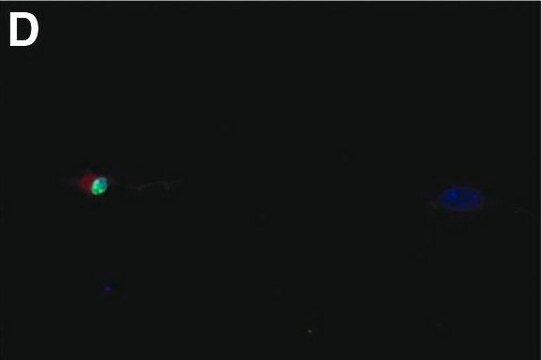推荐产品
生物源
mouse
品質等級
抗體表格
purified antibody
抗體產品種類
primary antibodies
無性繁殖
T49, monoclonal
物種活性
mouse, rat, bovine
應無反應活性
human
技術
immunohistochemistry: suitable
western blot: suitable
同型
IgG1κ
NCBI登錄號
UniProt登錄號
運輸包裝
wet ice
目標翻譯後修改
unmodified
基因資訊
human ... MAPT(4137)
mouse ... Mapt(17762) , Mapt(281296)
rat ... Mapt(29477)
一般說明
Tau,或称微管相关蛋白Tau(MAPT),也称为神经原纤维缠结蛋白、双股螺旋细丝tau(PHF-tau),是一种细胞质蛋白,促进微管的组装和稳定,并可能涉及神经元中轴突极性(axonal polarity )的形成和维持。Tau 结合轴突微管,并被认为是轴突微管和神经细胞质膜成分的连接蛋白(linker protein)。该蛋白有多种亚型,短的亚型赋予细胞骨架可塑性,而较长的亚型可能在其稳定中起一定作用。PAD 是磷酸酶激活结构域(phosphatase activating domain),研究表明,其通过激活轴突蛋白磷酸酶1(PP1)和糖原合成酶激酶3(GSK3),以独立于微管结合的形式,参与基于驱动蛋白的、顺行性快速轴突运输(fast axonal transport,FAT)。Tau的缺陷被认为是许多神经退行性疾病的原因,包括额颞叶痴呆(FTD)、pallido-ponto-nigral degeneration(PPND)、皮克脑病(PIDB)、皮质基底节变性(CB)、核上性麻痹1型(PSNP1)、阿尔茨海默病和帕金森病。 克隆T49对于牛、大鼠和鼠类Tau有免疫反应性,但是对人Tau(分别为UniProt P29172、P19332、P10637、P10636)没有免疫反应性。
免疫原
纯化态对应于牛 Tau。
應用
免疫组化分析:一个代表性批次以的1:1,000 稀释液在小鼠大脑皮层、小鼠肾脏和小鼠小肠组织组织中检测到Tau。
蛋白质印迹分析:一个代表性批次在PBS处理的或FL a-syn pffs A株系或B株系转染的PS19神经元中检测到Tau(Guo, J.L., et al. (2013).Cell. 154:103-117)。
蛋白质印迹分析:一个代表性批次在PBS处理的或FL a-syn pffs A株系或B株系转染的PS19神经元中检测到Tau(Guo, J.L., et al. (2013).Cell. 154:103-117)。
抗-Tau 抗体(克隆T49)(非人类)是针对Tau 的抗体,用于蛋白质印迹和免疫组织化学。
品質
通过蛋白质印迹在人 脑组织裂解物中进行了评估。
蛋白质印迹分析:0.5 µg/mL的该抗体在10 µg小鼠和人脑组织裂解物中检测到Tau。
蛋白质印迹分析:0.5 µg/mL的该抗体在10 µg小鼠和人脑组织裂解物中检测到Tau。
標靶描述
观测值〜53 kDa。该抗体具有45-76 kDa的多种亚型。
外觀
形式:纯化
其他說明
浓度:请参考特定批次的数据表。
未找到合适的产品?
试试我们的产品选型工具.
儲存類別代碼
12 - Non Combustible Liquids
水污染物質分類(WGK)
WGK 1
閃點(°F)
Not applicable
閃點(°C)
Not applicable
Distinct ?-synuclein strains differentially promote tau inclusions in neurons.
Guo, JL; Covell, DJ; Daniels, JP; Iba, M; Stieber, A; Zhang, B; Riddle, DM; Kwong, LK; Xu et al.
Cell null
Carlos G Sanchez et al.
Communications biology, 4(1), 736-736 (2021-06-16)
Aggregates of hyperphosphorylated tau protein are a pathological hallmark of more than 20 distinct neurodegenerative diseases, including Alzheimer's disease, progressive supranuclear palsy, and frontotemporal dementia. While the exact mechanism of tau aggregation is unknown, the accumulation of aggregates correlates with
Melissa Huang et al.
eNeuro, 9(6) (2023-01-13)
Alzheimer's Disease (AD) is characterized by the pathologic assembly of amyloid β (Aβ) peptide, which deposits into extracellular plaques, and tau, which accumulates in intraneuronal inclusions. To investigate the link between Aβ and tau pathologies, experimental models featuring both pathologies
我们的科学家团队拥有各种研究领域经验,包括生命科学、材料科学、化学合成、色谱、分析及许多其他领域.
联系技术服务部门